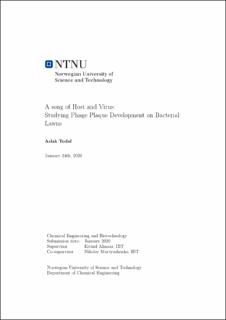| dc.contributor.advisor | Almaas, Eivind | |
| dc.contributor.advisor | Martyushenko, Nikolay | |
| dc.contributor.author | Todal, Aslak | |
| dc.date.accessioned | 2020-06-04T16:00:42Z | |
| dc.date.available | 2020-06-04T16:00:42Z | |
| dc.date.issued | 2020 | |
| dc.identifier.uri | https://hdl.handle.net/11250/2656637 | |
| dc.description.abstract | I denne masteroppgaven presenteres nye metoder, utstyr og en matematisk modell for undersøkelse av utviklingen av bakteriofagplakk i semisolid agar fylt med bakterier. Cellfiebooth-systemet, opprinnelig utviklet og introdusert i prosjektoppgaven «Fluorescence Imaging of the Pre-Visible Stage of Bacteriophage Plaque Formation», anvendes for å måle dannelsen av plakk. Systemet er basert på måling av DNA-distribusjon som følge av bakteriolyse indusert av bakteriofager. Den utviklede reaksjon- og diffusjonsmodellen forholder seg til diffusjonen av både næring og bakteriofager, og tar høyde for plakkens form og vekst. Gjennom komparasjon av eksperimentelle og teoretiske resultater, stadfestes det at diffusjon av næring fra plakkens innside er en vital driver for sen plakkekspansjon. Det blir også etablert at bakterieverter kan endre vekststrategi underveis i eksperimenters forløp, og at dette da vil ha alvorlige konsekvenser for plakkens morfologi. I tillegg utvikles en ny protokoll for bestemmelse av antall nye virus fra en infeksjon, tidsrommet mellom infeksjon og lysis, samt standardavvik for tidsrommet mellom infeksjon og lysis—alt i ett eksperiment. Jeg håper de presenterte utviklingene innen kontinuerlig måling og modellering av viral plakkutvikling kan være nyttig for lesere med som har fremgang innen bakteriofagterapi som hensikt. | |
| dc.description.abstract | This thesis presents novel methods, equipment, and a mathematical model for the study of bacteriophage plaque development on bacterial lawns in semi solid agar. The Cellfiebooth system, which I developed and first presented in my previous report "Fluorescence imaging of the pre-visible stage of bacteriophage plaque formation" is used as the method for measuring plaque development. The system is based on determining the distribution of DNA released by phage-induced bacterial lysis. The developed model is a reaction-diffusion model and considers the diffusion of both nutrient and phage, while focusing on the shape and growth of plaques in bacterial lawns. Comparing the experimental and theoretical results, it was found that the diffusion of nutrient from within the plaque is a vital driver for the late expansion of plaques. It was also found that the bacterial host can change growth strategy during the experiment, and that this will have severe consequences for plaque morphology. In addition, a new protocol was developed for determining the burst size, lysis time and standard deviation in the lysis time of a phage strain, all in a single experiment. I hope that the presented advances in the continuous measurement and modelling of viral plaque development, can be useful for readers aspiring to progress in the field of phage therapy. | |
| dc.language | eng | |
| dc.publisher | NTNU | |
| dc.title | A song of Host and Virus: Studying Phage Plaque Development on Bacterial Lawns | |
| dc.type | Master thesis | |
